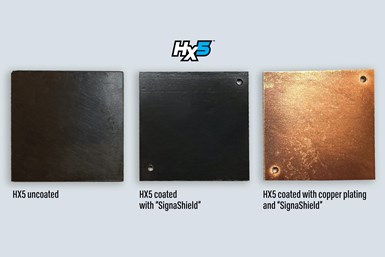Signashield Coating Eliminates Germs from Alpine's HX5
Alpine’s HX5, when coated with Signature Plating’s Signashield, displays antimicrobial properties that make it suitable for high-contact parts.

Samples of Alpine Advanced Materials’ (Dallas, Texas) HX5 coated with Signature Plating’s (Cibolo, Texas) Signashield antimicrobial clearcoat have showed a 99.93-percent reduction in Staphylococcus aureus, and a 99.92-percent reduction in E. coli.
“As manufacturers face heightened attention on microbe transmission, materials like HX5 will need to be evaluated through that lens, which is why we had this testing done,” says Roger Raley, president of Alpine Advanced Materials. “We learned that it not only coated beautifully with Signashield, but that it also virtually eliminated all harmful microbes when exposed, making it ideal for parts with surfaces that get a lot of contact traffic.”
Signature Plating’s Signashield meets ISO 22196:2011 standards for reducing microbes on part surfaces and preventing the spread of bacteria. The coated HX5 also meets this certification. Tests show surfaces coated with Signashield reduce microbial loads and the potential for cross-contamination, with the antimicrobial protection lasting for the lifetime of the coated part.
“If part coating can inherently be its own defense and not need to be cleaned as often, then you have a tremendous advantage,” adds Zane Leake, vice president of sales for Signature Plating. “We are constantly developing new finish processes to address market needs, and the combination of our decorative finishes with the antimicrobial protection of Signashield means Alpine parts can deliver weight savings along with a layer of tested and certified protection.”
HX5, an aviation-grade thermoplastic nanocomposite, replaces machined aerospace-grade aluminum at half the weight. Its high strength-to-weight ratio, thermal stability, environmental resistance, manufacturing flexibility, resistance to electromagnetic interference (EMI) and effective performance in high-radiation environments grant it operational versatility. Shops can injection mold, form, extrude or machine HX5 like aluminum, allowing for complex but strong shapes.
Alpine Advanced Materials | 469-490-1470 | alpineadvancedmaterials.com
Signature Plating | 210-658-5599 | signatureplating.com
Related Content
-
A Chromium Plating Overview
An overview of decorative and hard chromium electroplating processes.
-
Successful South African Plater Beating the Odds
Remaining focused on quality and reliability, Team Plating Works stays profitable in a volatile and challenging economy.
-
How to Maximize Nickel Plating Performance
The advantages of boric acid-free nickel plating include allowing manufacturers who utilize nickel plating to keep up the ever-changing regulatory policies and support sustainability efforts.
















